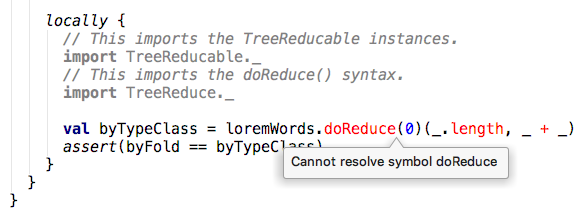That doesn’t look entirely right.
trait Aggregateable[M[_]] {
def foldLeft[A, B](m: M[A])(z: B)(op: (B, A) => B): B
}
We don’t depend on the generic type parameter for M in the signature, so it can be a val or, more convenient, an object:
implicit object ListAggregateable extends Aggregateable[List] {
override def foldLeft[A, B](m: List[A])(z: B)(op: (B, A) => B): B = m.foldLeft(z)(op)
}
However, this way we’d have to implement a type class instance for each concrete collection. I’ve tried to come up with an instance at TraversableOnce level. (Now requiring a def, indeed.) It kind of seems to work, but…
implicit def traversableOnceAggregateable[T[a] <: TraversableOnce[a]]: Aggregateable[T] =
new Aggregateable[T] {
override def foldLeft[A, B](m: T[A])(z: B)(op: (B, A) => B): B = m.foldLeft(z)(op)
}
…I have no idea how to interpret/explain the effect of the ‘a’ type parameter. I can’t use ‘_’ instead because then T[A] won’t be accepted as a subtype of TraversableOnce[A], and thus op will be rejected as an argument to #foldLeft(). Any explanation about what’s going on there (or just the proper term(s) to throw at a web search) would be appreciated.
Exactly. The signature would become
def treeAggregate[M[_] : Aggregateable, A, B](objects: M[A], init: B, seqop: A => B, combop: (B, B) => B): B
…and the #foldLeft() invocation would be implicitly[Aggregateable[M]].foldLeft(objects)(...).



